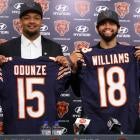Signings leading up to the start of the regular season took players that would have been highly sought after in free agency or franchise tag candidates off the market. Most notably, Matthew Stafford reset the quarterback market when the Lions signed him to five-year, $135 million contract extension with an NFL record $92 million of overall guarantees during the preseason. His $50 million signing bonus is the largest ever for an NFL player. The $60.5 million fully guaranteed at signing is also an NFL record.
DeAndre Hopkins helped advance the ball for wide receivers by setting new standards for pass catchers with $49 million in overall guarantees and $36.5 million fully guaranteed at signing. His five-year, $81 million extension from the Texans ranks second only to Antonio Brown (Steelers) with a $16.2 million average yearly salary.
Contract-year players that escape serious injury and poor performance in the final year of their deals could see increased attention or riches in free agency with the salary cap expected to continue increasing in 2018 at the roughly 8 percent rate it has been in recent years. This type of growth should put next year's cap in the $180 million range and keep producing deals during the first wave of free agency where good players are paid like elite players at their position and average players are overpaid.
Here are 15 players to keep an eye on during their contract year.
Cousins, who was designated as a franchise player for a second straight year, is playing the 2017 season for a fully guaranteed $23.9 million because he declined a Redskins offer reportedly worth $133 million over six years. This offer contained $72 million in overall guarantees, of which $53 million was fully guaranteed at signing. Under franchise tag rules, the Redskins are prohibited from signing Cousins to a multi-year contract until the end of the 2017 regular season on December 31.
Absent a long-term deal before the 2018 league year begins on March 14, Cousins will likely become an unrestricted free agent next offseason because of the high price of restricting him again. Although Redskins president Bruce Allen has indicated that designating Cousins as a franchise player in 2018 for a third and final time at almost $34.5 million is a possibility, it seems implausible, due to the steep cost. Another option is using a transition tag for $28.7 million, which would only give the Redskins a right to match another team's offer sheet.

Cousins could be a litmus for quarterback salaries should he become an unrestricted free agent. Quality quarterbacks almost never hit the open market.
This is predicated on Cousins performing like he has over the last two seasons when he has been one of the NFL's most productive quarterbacks statistically. Cousins has completed 68.3 percent of his passes for 9,083 yards with 54 touchdowns and 23 interceptions to post a 99.3 passer rating. He has the NFL's third-best completion percentage, is fourth in the NFL in passing yards, sixth in passer rating and 12th in touchdown passes during this span.
Cousins commanding $30 million per year with $100 million in guarantees as an unrestricted free agent after another good season isn't out of the question because there are more NFL teams than competent quarterbacks. Some of the quarterback-needy teams will have an abundance of cap space next offseason. Cousins' downside with a regression or mediocre season is probably the last offer he rejected from Washington averaging a little more than $22 million a season because of the shortage of quality quarterbacks.
The 38-year-old Brees is content to play out his contract, a one-year extension for $24.25 million signed early in the 2016 season, even though his preference is to finish his career in New Orleans. Brees hasn't showed signs of slowing down. He led the NFL with 5,028 passing yards in 2016. He completed 70 percent of the passes to rank second in completion percentage. He was also third with 37 touchdown passes and fifth with a 101.7 passer rating.
Brees' contract was structured with 2018 through 2020 contract years that automatically void next March 14, the last day of the 2017 league year. This voiding date eliminates the possibility of Brees being given a franchise tag since it is after the designation period ends on March 6. If an extension isn't worked out between the end of the season and the voiding date, the Saints will have an $18 million salary cap charge in 2018 regardless of where Brees plays next year because of the proration from the $30 million signing bonus he received with 2016 extension.
As long as Brees can continue to keep Father Time at bay, it may make sense to continue going year-to-year. 2018 could be converted into a real contract with a slight raise to put him closer to Stafford's average and the voiding of the 2019 and 2020 contract years is delayed until the last day of the 2018 league year in March 2019.
According to our own NFL insider Jason La Canfora, Bell rejected a contract offer the NFLPA found appropriate as the July 17 deadline for franchise players to sign multi-year deals approached. Previous reports had put the offer at more than $60 million over five years. La Canfora indicated the offer had $18 million in first year and $39 million over the first three years.

Pittsburgh's offer was substantially more than the current $8.25 million per year benchmark in a declining running back market. Bell was reportedly looking for at least $15 million per year to build upon the contract Adrian Peterson had been playing under since 2011 that averaged approximately $14 million per year before the Vikings released him in March. Whether Bell made a mistake turning down the deal remains to be seen. Pittsburgh has the option of placing another franchise tag on Bell in 2018 for $14.544 million, which is 120 percent of his current $12.12 million franchise number.
Graham set franchise records for a tight end with 65 receptions for 923 yards in a comeback 2016 season. In 2015, his first in Seattle, Graham tore the tore the patellar tendon in his right knee. Placing a franchise tag on Graham in 2018 is remote, and here's why: the 120 percent of the prior year's salary rules suggest that the signing bonus proration from Graham's deal with the Saints, which made him the NFL's first and only $10 million per year tight end, is included the calculations. With the bonus proration factored in, Graham's tag number should be $15.58 million. Fortunately for Seattle, the tight end market has been stagnant with Graham's deal still leading the way. A 31-year-old Graham may have a hard time getting the same money in 2018 he did at 27 without bettering the franchise marks he set last season during his contract year.
Bradford is going to be sitting in the driver's seat if he can maintain or improve upon his 2016 performance. He set an NFL single-season record with a 71.6 completion percentage and threw for a career high 3,877 yards while getting comfortable with Minnesota's offense on the fly after a surprising trade from the Eagles in the days leading up to the regular season opener.

The completion record is a byproduct of his passes only traveling 6.2 yards in the air, which was third-worst in the NFL last season. The Vikings will be hard-pressed to franchise Bradford during the offseason. The $5.5 million of 2017 signing bonus proration from his Eagles contract figures into the 120 percent calculation of his franchise number, like in Graham's case. The tender required to keep Bradford off the open market should be $28.2 million. Bradford could command a contract similar to Derek Carr's ($25 million per year with $70 million in overall guarantees) as a free agent since the demand for quality starting quarterbacks exceeds the supply.
Jeffery opted for a one year, $9.5 million contract (worth up to $14 million through incentives) after a 2016 season to forget. He served a four-game suspension without pay for violating the NFL's performance-enhancing drugs policy. During the 12 games Jeffery played, he seemed like an afterthought in the Bears' passing game at times because he never quite got in sync with the rotating cast of quarterbacks that were a necessity due to injury.
Jeffery was seeking a deal comparable to those of Dez Bryant, Demaryius Thomas, Julio Jones and A.J. Green. These deals, which were signed in 2015, average between $14 million and $15 million per year. With the exception of Green, the players received between $43.5 million and $47 million of guarantees in their contracts. A bounce-back season could put Jeffery in a position to get the type of contract that never materialized in free agency this year or more.
Ansah is one of the NFL's better pass rushers when healthy. He was third in the NFL with 14.5 sacks in 2015. A nagging ankle injury derailed a 2016 season in which he only had two sacks. Regaining his 2015 form could put Ansah in line for a contract averaging in excess of $16M per year with over $50 million in guarantees, which is going rate for good edge rushers. Getting Stafford signed long-term allows the Lions to franchise Ansah if necessary. The defensive end number is expected to be in the $17.5 million neighborhood in 2018.
Johnson was more interested in a long-term deal than the Rams, which is why he is playing under a franchise tag for a second straight season. On the bright side, the almost $30.7 million Johnson is making in 2016 and 2017 is the second-most money for a cornerback during this period behind only Josh Norman. The Redskins made Norman the NFL's highest-paid cornerback on an extremely front-loaded five-year, $75 million deal containing $50 million in guarantees in April 2016. This was a couple of days after the Panthers rescinded the franchise player designation they had placed on him.

Johnson won't be franchised for a third time in 2018. A third franchise tag will be the greater of the highest franchise number at any position, quarterback, or 144 percent of the Johnson's $16,742,400 2017 salary. The minimum for a third franchise player designation is just under $24.11 million. Replacing Norman as the NFL's top-paid cover man in 2018 free agency is conceivable with a strong season.
Richardson got the change in scenery that had been in the works for about a year with a trade to the Seahawks before the roster cutdown to 53 players almost two weeks ago. The Jets had one too many quality 3-4 defensive ends with Muhammad Wilkerson and Leonard Williams on the roster. Richardson's long-term prospects with the Jets took a hit when his former defensive linemate Wilkerson signed a five-year, $86 million contract with $53.5 million in overall guarantees last summer.
If Richardson, the 2013 NFL Defensive Rookie of the Year, can put some distance between his well-documented off-the-field problems while playing up to his enormous potential, it could mean a bigger payday than Wilkerson's, whose contract may be an important salary data point to him next offseason. Richardson served a one-game suspension to start the 2016 season for a personal conduct policy violation in connection with high-speed racing and resisting arrest charges in Missouri during 2015. He was also suspended for the first four games in 2015 under the substance abuse policy because of repeated marijuana usage.
Landry and the Dolphins haven't had discussions about a contract extension, even though he is tied with former LSU teammate Odell Beckham, Jr. for the most receptions during the first three seasons of an NFL career. His 288 receptions are also tied for the fourth-most over the last three seasons. Head coach Adam Gase felt compelled to quash rumors recently that the Dolphins were listening to trade offers for the league's most productive slot wide receiver.

Landry sustaining his pace of production this season will be challenging. He doesn't have the type of chemistry with recently-signed quarterback Jay Cutler that he had with Ryan Tannehill, who is out for the season after surgery to repair the ACL in his left knee. Devante Parker, the Dolphins' 2015 first-round pick, could be poised for a breakout year. Cutler has called him a faster Alshon Jeffery. Whether the Dolphins use a franchise tag on Landry in 2018 could hinge on Parker's progress. The wide receiver figure should be in the $16.25 million neighborhood in 2018.
Bill Belichick made a rare high-priced free-agent signing by landing cornerback Stephon Gilmore from the Bills, a division rival, with a five-year, $65 million contract containing $40 million in guarantees. He essentially gave Gilmore the money Butler wanted from the Patriots. The Saints showed some interest in Butler, a restricted free agent, but weren't willing to sign the 2014 undrafted free agent to an offer sheet because the 11th overall pick in the 2017 NFL draft was too big of a price to pay. Butler is probably playing his final season in New England since Belichick investing heavily in two cornerbacks would be a surprise.
Pryor was brought in to help offset the loss of wide receivers Pierre Garcon and DeSean Jackson in free agency. The converted quarterback is betting on himself with a one-year, $6 million deal (worth as much as $8 million through incentives). A contract for significantly more than the four-year, $32.5 million deal containing $17 million in guarantees that Kenny Britt took to replace Pryor with the Browns should be available next offseason, provided the 6-foot-4, 228 pound speedster is correct that he is just scratching the surface of talent at wide receiver.
Eifert was one of the NFL's best red-zone threats in 2015. He led NFL tight ends with 13 touchdown receptions. He may need to stay healthy in order to get a long-term deal like comparable tight ends in the 2013 draft class. Zach Ertz, Travis Kelce and Jordan Reed have signed long-term extensions averaging between $8.5 million and $9.35 million per year. Eifert missed most of the 2014 season with an elbow injury. He missed nearly half of the 2016 season because of an ankle injury suffered in the Pro Bowl several months before. An inability to erase concerns about durability could prompt the Bengals to place a franchise tag on Eifert, which should be in $10.25 million neighborhood.
The two-year, $20 million extension (with a maximum value of $21.562 million) that Solder signed at the start of the 2015 regular season contains a clause prohibiting the Patriots from designating him as a franchise or transition player when his contract expires after the season. Solder is in an enviable position because good left tackles are valuable commodities in free agency. The Chargers made Russell Okung the NFL's highest-paid offensive lineman (by average yearly salary) with a four year, $53 million deal that has $25 million fully guaranteed in free agency this year, even though he isn't anybody's idea of a great pass protector.
Norwell could be the next big beneficiary of the explosion in offensive guard salaries. Seven guards (Kevin Zeitler, Kelechi Osemele, Trai Turner, Gabe Jackson, David DeCastro, Kyle Long and Joel Bitonio) have hit or cracked the $10 million per year mark since the start of the free agency in 2016. None existed before then.
Most notably, the Panthers recently gave Turner, Norwell's counterpart at guard, a four-year, $45 million extension with $20.5 million in guarantees. Similar money will likely be required for Carolina to keep Norwell in the fold. Designating Norwell as a franchise player is unrealistic. He would receive a one-year financial windfall because the franchise tag doesn't account for the salary differences at the three main offensive line positions (center, guard and tackle). The 2018 offensive line number should be around $14.5 million.













































